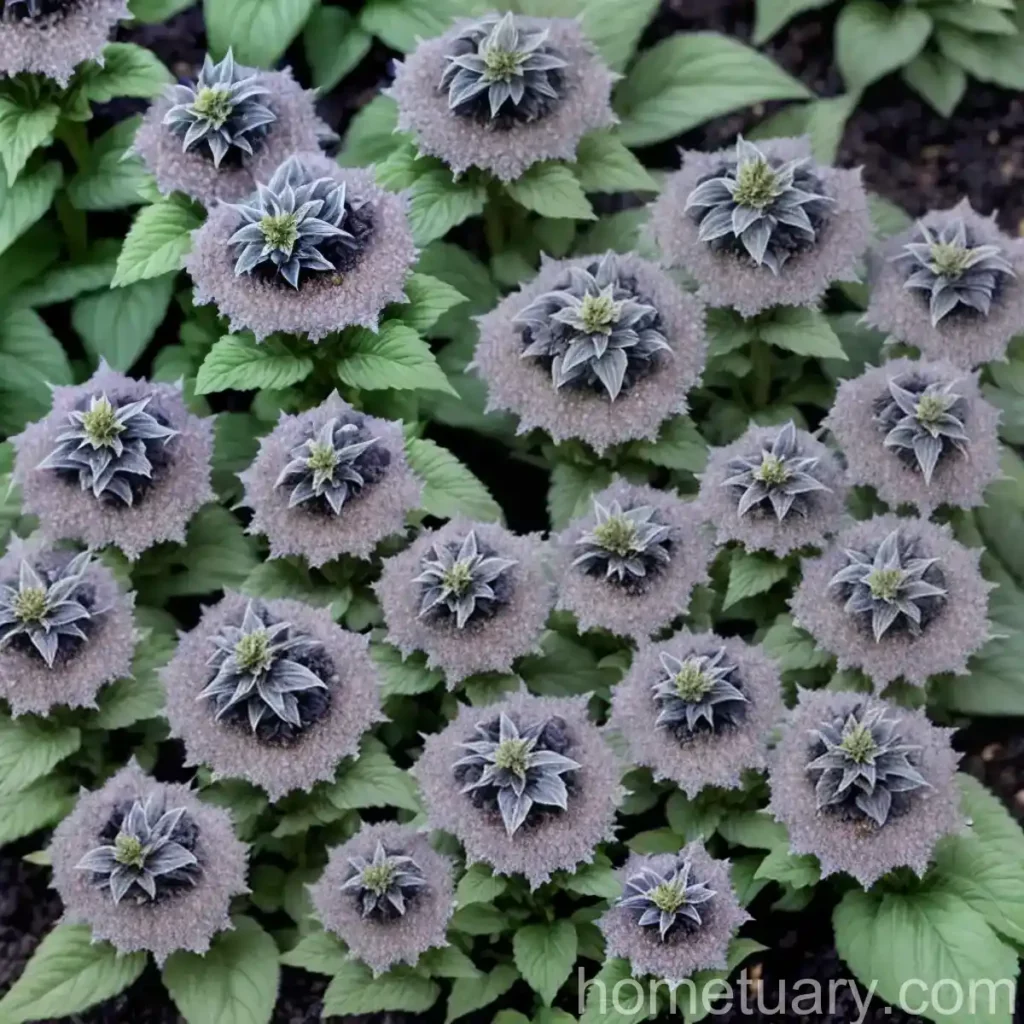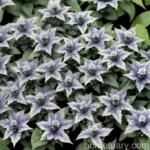Bugleweed (Ajuga reptans ‘Toffee Chip’)
What is Bugleweed?
Bugleweed, also known as Ajuga reptans ‘Toffee Chip’, is a low-growing perennial plant appreciated for its ornamental foliage and vibrant flowers. It is a member of the Lamiaceae family, commonly referred to as the mint family, and is native to Europe. This plant is characterized by its vibrant, variegated leaves and dense clusters of blue, purple, or white flowers that bloom in the spring.
Key Takeaways – Bugleweed (Ajuga reptans ‘Toffee Chip’)
- Scientific Name: Ajuga reptans ‘Toffee Chip’
- Common Name: Bugleweed
- Plant Type: Perennial
- Family: Lamiaceae
- Native Region: Europe
- Foliage: Variegated, vibrant colors
- Flowers: Blue, purple, or white clusters
- Ideal Uses: Ground cover, ornamental borders, containers
- Attracts: Pollinators, wildlife
- Special Feature: Low maintenance, drought-tolerant
In this blog, we’ll delve into the various aspects of Bugleweed, including its cultural requirements, uses in landscaping, common diseases and pests, as well as propagation and maintenance tips.
Culture
Bugleweed is highly adaptable and can thrive in a variety of conditions, making it a popular choice for gardeners seeking low-maintenance and visually appealing plants. Understanding the cultural requirements of Bugleweed is essential for ensuring its optimal growth and performance in different settings.
Water
Bugleweed prefers consistently moist soil, especially during its establishment phase. Regular watering is essential in the absence of rainfall, particularly in hot and dry climates. However, established Bugleweed plants exhibit good drought tolerance, making them suitable for xeriscaping and low-water gardens once they are well-rooted.
Sunlight
While Bugleweed thrives in partially shaded areas, it can also tolerate full sun with proper moisture and soil conditions. In warmer regions, providing some afternoon shade can prevent excessive stress on the plant during hot summers. In contrast, cooler regions may allow Bugleweed to flourish in more sun-exposed locations.
Fertilizer
Bugleweed typically does not require heavy feeding. A balanced, slow-release fertilizer applied in the spring can provide the necessary nutrients for healthy growth and vibrant foliage. However, it’s essential to avoid over-fertilization, as this may lead to excessive vegetative growth at the expense of flower development.
Soil
This plant prefers well-draining, slightly acidic to neutral soil. Amending the soil with organic matter such as compost or peat moss can enhance its moisture retention and nutrient content. Additionally, ensuring good drainage is crucial, as Bugleweed can be susceptible to root rot in waterlogged conditions.
Pruning
Regular pruning is beneficial for managing the growth and appearance of Bugleweed. In late spring, after the initial flowering period, trimming back the spent flower spikes and any leggy growth can promote a more compact and bushy form. This practice also encourages the development of new foliage and potential reblooming.
Propagation
Bugleweed can be propagated through various methods including division, cuttings, and seed.
- Division: Divide established clumps of Bugleweed in early spring or early fall to create new plants.
- Cuttings: Take stem cuttings in the summer, and root them in a moist, well-draining medium to establish new plants.
- Seed: Collect and sow seeds in the fall for germination the following spring.
Each propagation method has its own requirements, but all can yield successful results when carried out with care and attention to detail.
Container Popularity
Bugleweed is a popular choice for container planting due to its compact growth habit and vibrant foliage. When grown in containers, Bugleweed can serve as an attractive addition to patios, balconies, or outdoor seating areas. Its cascading form makes it particularly well-suited for hanging baskets or elevated planters, where its colorful leaves can drape gracefully over the edges.
Container Common Diseases
When growing Bugleweed in containers, it’s important to watch for potential diseases that may affect the plant. Some common container diseases that may impact Bugleweed include:
- Root Rot: Overly wet soil or poor drainage can lead to root rot, which is a common issue in container plants.
- Powdery Mildew: This fungal disease can develop in humid or poorly ventilated conditions, causing a powdery white growth on the foliage.
Careful monitoring and proper plant care can help prevent and manage these diseases in container-grown Bugleweed.
Disease Diagnosis
Diagnosing diseases in Bugleweed (Ajuga reptans ‘Toffee Chip’) involves observing the plant closely for any signs of discoloration, wilting, or abnormal growth. Certain symptoms, such as yellowing leaves, spotted foliage, or stunted growth, may indicate specific diseases or environmental stressors. Identifying the underlying cause of the symptoms is crucial for implementing effective treatment and preventive measures.
Common Pests
While Bugleweed is relatively resistant to many pests, it may occasionally face challenges from certain insects, such as:
- Aphids: These small, sap-feeding insects can congregate on the tender new growth of Bugleweed, causing distortion and stunted development.
- Slugs and Snails: These pests are particularly attracted to the lush foliage of Bugleweed and can cause unsightly damage through feeding.
- Crown Rot: Overly moist conditions can lead to crown rot, affecting the base of the plant and causing wilting and decline.
Vigilant monitoring and prompt intervention can help control pest populations and prevent extensive damage to Bugleweed.
Botanist’s Tips
As a plant scientist, here are some valuable tips for optimizing the growth and performance of Bugleweed in various settings:
- Site Selection: Choose a location with well-draining soil and partial shade for best results.
- Mulching: Applying a layer of organic mulch around Bugleweed can help maintain soil moisture and suppress weeds.
- Divided Planting: Dividing and replanting Bugleweed every few years can rejuvenate its growth and vigor.
- Regular Inspection: Periodically inspect Bugleweed for signs of disease or pest infestations, and take appropriate action if needed.
Fun Facts
- Bugleweed is often used as a ground cover in landscapes due to its spreading habit and attractive foliage.
- Its flowers are a valuable source of nectar for pollinators, attracting bees and butterflies to the garden.
- The variegated leaves of ‘Toffee Chip’ cultivar offer a stunning display of colors, ranging from creamy yellow to rich burgundy.
Links to External Resources
For further information on Bugleweed (Ajuga reptans ‘Toffee Chip’) and related topics, consider exploring the following resources:
- The Royal Horticultural Society – Ajuga reptans ‘Toffee Chip’ Plant Profile
- University of Maryland Extension – Growing and Propagating Ajuga
- American Society for the Prevention of Cruelty to Animals – Pet-Safe Plants: Bugleweed
- The National Gardening Association – Bugleweed Plant Care Guide
As a plant scientist, it’s fascinating to explore the diverse aspects of Bugleweed, from its cultural requirements to its potential uses in landscaping and its essential role in supporting biodiversity. By understanding and appreciating the unique characteristics of Bugleweed, gardeners can incorporate this versatile plant into their outdoor spaces, creating stunning visual displays and promoting a healthy ecosystem. Whether used as a ground cover, border plant, or container specimen, Bugleweed adds a touch of natural elegance to any setting, making it a valuable asset in horticulture and garden design.
I hope this blog provides valuable insights into the world of Bugleweed and inspires a deeper appreciation for this exceptional plant. Happy gardening!















